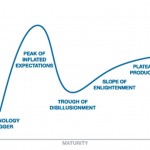
The backlash from some corners of higher education against the proliferation of massive open online courses (MOOCs) could be an essential step that many other technological innovations had to endure before finding footing in a sector or industry.
In other words, faculty members refusing to adopt MOOC courses and colleges and universities rejecting major MOOC providers is a natural step toward normalization for MOOCs and the companies that host the courses.
Gartner, the information technology research firm, has applied its Hype Cycle graphic to myriad emerging technologies since 1995, using it as a “representation of the maturity and adoption of technologies and applications, and how they are potentially relevant to solving real business problems and exploiting new opportunities.”
From 3D printing to Internet TV to big data, technologies move through a projected cycle, beginning with a “technology trigger,” moving toward a “peak of inflated expectations,” on to a “trough of disillusionment” until the technology reaches a “slope of enlightenment,” and finally, a “plateau of productivity.”
Joshua Kim, director of Learning and Technology for the Master of Health Care Delivery Science program at Dartmouth College, wrote in a May 21 blog post that MOOC technology has already passed the “peak of inflated expectations” and may be in the midst of the “trough of disillusionment,” as MOOC skepticism spreads across higher education despite broad institutional excitement about the courses.
“The concerns of faculty certainly are valid,” Kim wrote. “[A]ny counterweight to the MOOC ‘peak of inflated expectations’ should be welcome. How else will higher ed and online education at scale get to the next steps in a classic evolution[?]”
See Page 2 for how a technology moves through the final two parts of the Hype Cycle.
Gartner, in its description of the Hype Cycle, says the “trough of disillusionment” is reached when “interest wanes as experiments and implementations fail to deliver. Producers of the technology shake out or fail. Investments continue only if the surviving providers improve their products to the satisfaction of early adopters.”
This part of the Hype Cycle is followed by newfound and compelling examples of “how the technology can benefit the enterprise start to crystallize and become more widely understood,” according to Gartner.
Kim, while charging that it’s encouraging to see MOOCs moving through the Hype Cycle – even through the disillusionment part – said faculty and other skeptics should consider embracing the technology.
“If anything, the spread of MOOCs will be a positive development for all faculty, as MOOCs focus attention on teaching,” Kim wrote. “The best thing about a MOOC is not what it does for the learners engaged in the course, or the faculty member teaching the class, but what the MOOC does (or should do) for every course on campus.”
- Research: Social media has negative impact on academic performance - April 2, 2020
- Number 1: Social media has negative impact on academic performance - December 31, 2014
- 6 reasons campus networks must change - September 30, 2014


Comments are closed.